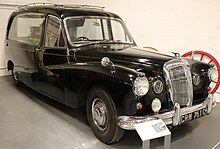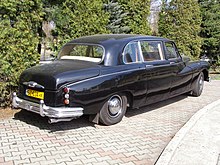Daimler DR450
| Daimler | |
|---|---|
|
Daimler DR 450
|
|
| Daimler DR450 | |
| Production period: | 1961-1968 |
| Class : | Upper class |
| Body versions : | Limousine , landaulet |
| Engines: |
Otto engine : 4.6 liters (162 kW) |
| Length: | 5740 mm |
| Width: | 1868 mm |
| Height: | 1615 mm |
| Wheelbase : | 3505 mm |
| Empty weight : | 2122 kg |
| Previous model | Daimler DK400 |
| successor | Daimler DS420 |
The Daimler DR450 is an eight-seater representation sedan from the British car manufacturer Daimler , which was produced in small numbers from 1961 to 1968. The DR450, which has won several design awards, is the last model from the Daimler brand that does not use Jaguar technology. Mechanics and essential body parts correspond to the shorter Daimler Majestic Major .
History of origin
The Daimler Motor Company, founded in 1896, was one of the most exclusive British automobile manufacturers in the first half of the 20th century. The company, which has been part of the Birmingham Small Arms Company (BSA) since 1910 , regularly supplied vehicles for the British royal family . The position of the company changed after the end of the Second World War , when the competitor Vanden Plas gradually took over the market leadership in the field of large sedans. Daimler then tried to serve lower-priced market segments with the Consort and Conquest models in parallel with the representative vehicles that were still being produced , but remained unsuccessful. The Majestic sedan presented in 1958 was intended to strengthen Daimler's position in the luxury class, but even in the high-performance eight-cylinder Majestic Major version introduced in autumn 1960, it was unable to save the brand, which had run into financial difficulties. In 1960 BSA sold the Daimler Motor Company to Jaguar, the then still independent sports car manufacturer . In the Jaguar-Daimler group, Daimler assumed the role of the top brand. In order to continue to be represented in the representative vehicle segment, Jaguar launched the DR450 in 1961, a version of the Majestic Major that was more than half a meter longer, the development of which had been initiated by the old Daimler management. It replaced the outdated DK400 sedan . In addition to the complete vehicle, Daimler also offered ready-to-drive DR450 chassis that independent body construction companies occasionally used as the basis for hearses . The DR450 was produced until 1968.
The Daimler DR450 has received several awards. In the 1960s, the DR450 won three silver medals for body construction at the Earls Court Motor Show in London , most recently in 1968 in its final year of production.
Model description
Technically and stylistically, the DR450 is an extended version of the Daimler Majestic Major. He takes over the drive technology and essential parts of the body from him.
Chassis and running gear
The Daimler DR450 has a box frame , the construction of which corresponds in principle to that of the Majestic and Majestic Major sedans; in the DR450, however, it is extended by 610 mm. The front wheels are individually suspended , a rigid axle with leaf springs is installed at the rear . There are servo-assisted disc brakes from Dunlop on all four wheels .
Engine and power transmission
Like the shorter Majestic Major, the Daimler DR450 has an eight-cylinder V-engine designed by Edward Turner with a displacement of 4.6 liters (4561 cm³). Daimler stated the engine output of the 4.6 liter version with 220 bhp (164 kW, 223 PS), which some press reports consider an understatement. A three-speed automatic transmission from BorgWarner transfers the power to the rear wheels.
body
Daimler outsourced the design and construction of the body to special companies. In the spring of 1960, Daimler commissioned both Carbodies , its regular bodywork supplier , and its competitor Motor Panels to design and build prototypes. Both proposals were adopted by the front and rear of the Daimler Majestic Major. Carbodies' first draft also included the unchanged doors of the Majestic Major. To lengthen the body, a spacer plate was inserted between the front and rear doors. In the engine panel design, however, the spacer plates were attached between the rear doors and the wheel arches. The rear doors have been redesigned for this; they have a vertical finish. The Daimler management decided in favor of series production of the engine panel design. Only a few details such as the roof line were revised by Daimler's in-house designer Osmond Rivers.
The DR 450 is a closed vehicle as standard. Individual copies were, however, delivered at the customer's request as landaulets with a fold-down fabric top over the rear seats. One of the landaulets went to the King of Thailand .
The DR 450 was delivered from the factory with an electrically operated glass partition between the driver and passenger compartments. Like the base vehicle, it has a three-seater bench seat at the back, which can be covered with either fabric or leather, as the customer chooses. There are also two folding seats. Including the front bench with three seats, the DR450 can carry a total of eight people.
Performance
The DR450, like the Major Majestic on which it is based, is a very fast car for its time. Despite its heavy weight, it has a top speed of 177 km / h (110 mph).
production
The bodies of the Daimler Majestic Major were produced in series by Carbodies. The Coventry- based automotive supplier Park Sheet Metal was responsible for extending the body and the frame . The conversion was done by hand.
The DR450 was presented to the public in September 1961. By 1968, 864 copies were made.
Market positioning and group policy
The Daimler DR450 was sold almost exclusively in Great Britain and the other Commonwealth countries. In addition to its function as a representative vehicle, it was mainly used in the rental car business and was often used as a transport vehicle for family celebrations such as weddings and funerals.
In Great Britain in the 1960s, in addition to the Daimler DR450 with the Vanden Plas Princess 4 liter sedan and the Rolls-Royce Phantom V, there were two other series-produced long sedans that were technically and stylistically outdated. The Rolls-Royce was not a direct competitor, if only because of its high price of £ 10,700. The Vanden Plas Princess 4 liter sedan, on the other hand, which was built by the British Motor Corporation (BMC), served the same market as the Daimler DR450. Both cars were sold for roughly the same price. The DR450, including taxes, was £ 3,500 when it launched, while the BMC was asking for the Vanden Plas for £ 3,473.
The Daimler DR450 did not cover costs for Jaguar in the 1960s. But it made sense because Jaguar, as an independent manufacturer, was able to document its claim as a luxury manufacturer in this way. The coexistence of the Daimler DR450 and the Vanden Plas sedan only changed when Daimler's parent company Jaguar lost its independence. After Jaguar and Daimler had been integrated into the BMC Group at the beginning of 1967, BMC had two completely different sedans in its range that were positioned in the same market segment. In the summer of 1968 BMC then stopped production of both the Daimler DR450 and the Vanden-Plas-Linousine. BMC replaced both with the newly developed Daimler DS420 , which, regardless of its brand name, was based entirely on (older) Jaguar technology.
Hearses

In addition to the complete vehicle, Daimler offered ready-to-drive DR450 chassis for which only individual body parts were supplied. The price for a chassis when the DR450 was launched in 1961 was £ 1,899. These chassis were used by several independent body manufacturers as the basis for funeral vehicles, whereby the base vehicle was often referred to as the Daimler Majestic Major for marketing reasons. Modifications came from Bristol Coach Builders in Bristol and Startin in Birmingham , among others .
literature
- David Culshaw, Peter Horrobin: The Complete Catalog of British Cars 1895-1975 , Poundbury, Veloce Publishing, 2013, ISBN 978-1-845845-83-4
- Brian Long: Daimler & Lanchester. A Century of Motor History , Longford International Publications, 1995, ISBN 1899154019
- Lord Montagu of Beaulieu, David Burgess-Wise: Daimler Century . Patrick Stephens Ltd., 1995, ISBN 1-85260-494-8
- NN: The Daimler V8s . In: The Driving Member. The Official Journal of the Daimler & Lanchester Owners Club. July 1999, p. 7 ff.
- Richard Townsend: Docker's Daimlers. Daimler and Lanchester Cars 1945 to 1960 , Amberley Publishing, Stroud, 2017, ISBN 978 1 4456 6316 6
Web links
Individual evidence
- ^ Lord Montagu of Beaulieu, David Burgess-Wise: Daimler Century . Patrick Stephens Ltd., 1995, ISBN 1-85260-494-8 , p. 272.
- ^ A b Brian Long: Daimler & Lanchester. A Century of Motor History, Longford International Publications, 1995, ISBN 1899154019 , p. 253.
- ^ Brian Long: Daimler & Lanchester. A Century of Motor History , Longford International Publications, 1995, ISBN 1899154019 , p. 287.
- ^ A b c Brian Long: Daimler & Lanchester. A Century of Motor History . Longford International Publications, 1995, ISBN 1899154019 , p. 268.
- ↑ Technical data of the Daimler DR450 on the website www.motor-car.net (accessed on January 26, 2020).
- ↑ a b c d Richard Townsend: Docker's Daimlers. Daimler and Lanchester Cars 1945 to 1960 , Amberley Publishing, Stroud, 2017, ISBN 978 1 4456 6316 6 , p. 69.
- ^ Brian Long: Daimler & Lanchester. A Century of Motor History , Longford International Publications, 1995, ISBN 1899154019 , p. 279.
- ↑ a b Lord Montagu of Beaulieu, David Burgess-Wise: Daimler Century . Patrick Stephens Ltd., 1995, ISBN 1-85260-494-8 , p. 280.
- ^ Brian Long: Daimler & Lanchester. A Century of Motor History , Longford International Publications, 1995, ISBN 1899154019 , p. 277.
- ^ Lord Montagu of Beaulieu, David Burgess-Wise: Daimler Century . Patrick Stephens Ltd., 1995, ISBN 1-85260-494-8 , p. 281.
- ^ Brian Smith: The Daimler Tradition . Transport Bookman Publications, London, 1972, ISBN 0 85184 004 3 , p. 300.
- ^ Brian Long: Daimler & Lanchester . A Century of Motor History, Longford International Publications, 1995, ISBN 1899154019 , p. 268.
- ↑ NN: The Vanden Plas 4-Liter Princess Limousine ; The Motor dated April 11, 1962.
- ↑ sale display of a "Majestic Major" -Umbaus Bristol Coach Builders (accessed on 31 January 2020).
- ↑ Nick Walker: A – Z of British Coachbuilders 1919–1960 . Shebbear 2007 (Herridge & Sons Ltd.) ISBN 978-0-9549981-6-5 , p. 173.
| Timeline of the Daimler models from 1945 to 1969 | |||||||||||||||||||||||||
|---|---|---|---|---|---|---|---|---|---|---|---|---|---|---|---|---|---|---|---|---|---|---|---|---|---|
| Type \ vintage | BSA | jaguar | BMH | British Leyland | |||||||||||||||||||||
| 1940s | 1950s | 1960s | |||||||||||||||||||||||
| 5 | 6th | 7th | 8th | 9 | 0 | 1 | 2 | 3 | 4th | 5 | 6th | 7th | 8th | 9 | 0 | 1 | 2 | 3 | 4th | 5 | 6th | 7th | 8th | 9 | |
| upper middle class | DB18 | Consort / Empress I. | Conquest / Century | 2½ liter V8 | V8-250 | ||||||||||||||||||||
| Special Sports | Conquest Roadster / DHC | ||||||||||||||||||||||||
| Upper class | DE27 / DH27 | Regency / Empress II-III | Majestic | Sovereign | |||||||||||||||||||||
| 104 / Sportsman | Majestic Major | ||||||||||||||||||||||||
| DE36 | DK 400 / Empress IV | DR 450 | DS 420 | ||||||||||||||||||||||
| Sports car | SP 250 | ||||||||||||||||||||||||



